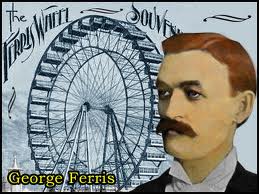The second edition of Tales Behind the Tombstones isn’t scheduled to be released for a year, but I couldn’t resist sharing one of the tales now. The symbol of the Chicago World’s Fair of 1893 was a giant 250-foot steel wheel, designed and erected under the supervision of George W. G. Ferris, Jr. It had 36 wooden seats that allowed 1,440 to ride at a time, taking them 25 stories above the fair at a then-exorbitant price of fifty cents apiece. The wheel was considered a wonder of technology and made Ferris, a former bridge inspector, a famous and a wealthy man during its heyday. But in 1896 he was worried about where future money would come from and, some believed because of his stress contracted typhoid fever. He died five days after its onset at age thirty-seven. Reports suggested that it was suicide, since his wife had left him three months before and he was apparently heartbroken and depressed. The wheel was moved and reassembled in New Orleans for the 1904 fair. However, two years later, what many felt was the American Eiffel Tower was dynamited, its rusted spokes buried in a landfill. Ferris’s name still stands on thousands of rides as a legacy-ironic that, since no one ever came to claim his cremated ashes. 
Follow Me
© 2025 Chris Enss | Privacy Policy | Design by Winter Street Design Group | Login

